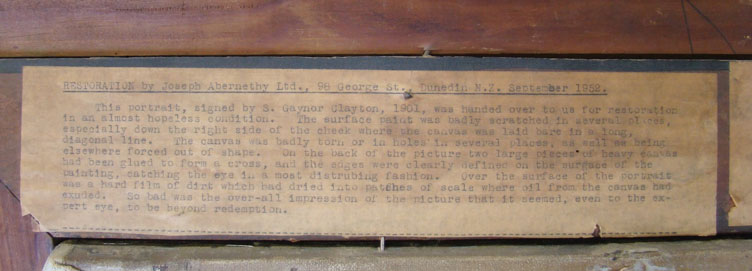It is not always the front of a picture which tells a story. We recently had to temporarily de-install this painting from our Material Cultures Gallery.
(2003/84/1 – Grace Lillian Mitchell.)
While it was in the Conservation Lab I took the opportunity to assess it and came across a typed restoration treatment report adhered to the top of the frame.

Photo: Toitū Otago Settlers Museum.
The restoration was carried out by a Dunedin company called Joseph Abernethy Ltd in George Street in 1952.The phrase that caught my eye was how prior to restoration the painting was in ‘hopeless condition’. The report continues to outline how the painting was restored and how it should be handled in the future.

Photo: Toitū Otago Settlers Museum.
‘This portrait, signed by S. Gaynor Clayton, 1901, was handed over for restoration in an almost hopeless condition. The surface paint was badly scratched in several places, especially down the right side of the cheek where the canvas laid bare in a long diagonal line. The canvas was badly torn or in holes in several places, as well as being elsewhere forced out of shape. On the back of the picture two large pieces of heavy canvas had been glued to form a cross, and the edges were clearly defined on the surface of the painting, catching the eye in a most disturbing fashion. Over the surface of the portrait was a hard film of dirt which had dried into patches of scale where oil from the canvas had exuded. So bad was the over-all impression of the picture that it seemed, even to the expert eye, to be beyond redemption.
This is invaluable information for the painting’s conservation record. The painting came into the collection in 2003, so without this information on the frame we would have had, to a certain extent, made educated conjectures about what had happened to the painting in the past.

Photo: Toitū Otago Settlers Museum.
Today, we use an ‘electronic typewriter’ and document condition and treatment reports using a database called Vernon. I have to admit the condition reports I write today are not as dramatic in their prose as those in 1952.
The painting is back on the wall in the Material Cultures gallery so make sure to pop by and have a look the next time you are in the museum
Fiona McLaughlan – Conservator

(2003/84/1 – Grace Lillian Mitchell.) Photo: Toitū Otago Settlers Museum